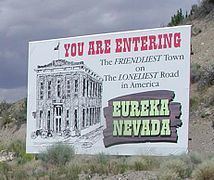Country United States FIPS code 32-23900 Elevation 1,977 m Population 610 (2010) Local time Thursday 3:24 AM | Time zone Pacific (PST) (UTC-8) GNIS feature ID 840384 Area 3.6 km² Zip code 89316 Number of airports 1 | |
 | ||
Weather -2°C, Wind S at 13 km/h, 72% Humidity | ||
Eureka is a census-designated place in and the county seat of Eureka County, Nevada, United States. With a population of 610 as of the 2010 census, Eureka is by far the largest community in Eureka County. Attractions include the Eureka Opera House (built in 1880 and restored in 1993), Raine’s Market and Wildlife Museum (built 1887), the Jackson House Hotel (built 1877), and the Eureka Sentinel Museum (housed in the 1879 Eureka Sentinel Newspaper Building).
Contents
- Map of Eureka NV 89316 USA
- Geography and climate
- History
- Public services
- Celebrations
- Sports
- Transportation
- Notable people
- References
Map of Eureka, NV 89316, USA
Eureka is part of the Elko Micropolitan Statistical Area.
Geography and climate
Eureka is located at 39°30′42″N 115°57′42″W, in the southern part of Eureka County, at 6,481 feet (1,975 m) in the Diamond Mountains, in a draw on the southern end of Diamond Valley, between Antelope and Newark valleys. At the 2010 census the population of Eureka CDP (census-designated place) was 610, while the total population of Eureka and the surrounding area (census tract 1 — Eureka CCD) was 1,373.
The town is located along the Lincoln Highway / U.S. Route 50, nicknamed "The Loneliest Road in America": aptly named, as the nearest towns along the highway are Austin (70 mi or 110 km west) and Ely (77 mi or 124 km east). The nearest town is Duckwater, 46 mi (74 km) south.
The climate is typical of the Great Basin: hot and dry with cool mornings in the summer with occasional monsoonal thunderstorms from late July through August; cold and relatively dry in the winter. Temperatures drop to 0 °F or −17.8 °C or lower on an average 4.7 mornings during the winter, though in the severe winter of 1916/1917 this happened twenty-five times. They drop to 32 °F or 0 °C on an average 181.3 mornings, though maximum temperatures top freezing on all but 26.3 days during an average winter. During the summer temperatures rise to 90 °F or 32.2 °C or hotter on 11.8 afternoons, though 100 °F or 37.8 °C has never been reached with the hottest temperature being 99 °F or 37.2 °C on July 14, 1955. Snow accumulations vary from 10 to 30 inches (0.25 to 0.76 m) in mild winters to in excess of 80 inches (2.03 m) in more severe years; in the winter of 1906/1907, more than 150 inches or 3.81 metres of snow fell.
The wettest calendar year has been 1941 with 23.86 inches (606.0 mm) and the driest 2008 with 5.64 inches (143.3 mm), whilst May 1917 with 5.73 inches (145.5 mm) has been the wettest single month. The snowiest month has been March 1902 with 54.0 inches or 1.37 metres of fresh snowfall.
History
The town was first settled in 1864 by a group of silver prospectors from nearby Austin, who discovered rock containing a silver-lead ore on nearby Prospect Peak. The town became the county seat in 1873, when Eureka County was carved out of adjacent Lander, Elko, and White Pine counties.
Mining, especially for lead, was the town's economic mainstay, as the nearby hillsides ranked as Nevada's second-richest mineral producer, behind western Nevada's Comstock Lode. Two of the largest concerns in Eureka were the Richmond Mining Company and the Eureka Mining Company. These two companies often collided, and in one instance, their litigation reached the U.S Supreme Court. The population boomed, reaching a high of 10,000 by 1878, but shrank as decreasing mine production and changing market conditions led to the closing of mines.
Public services
Eureka is served by an all-volunteer fire department, which provides fire protection, rescue, and vehicle rescue services for Eureka and the surrounding areas. In 2009 a new brick and steel fire house was built on Main Street in Eureka. At the time of its building it was the second largest fire house in the state. In addition to being a modern fire fighting facility, it contains a museum of Eureka fire department equipment and vehicles dating back to the 1870s. The fire-museum may be viewed through the large glass windows, or a tour may be taken by contacting a local fireman.
Eureka boasts three parks, a modern enclosed swimming facility, two baseball fields, a track, and football field.
The 1880s Eureka Opera House was re-modeled in recent times and regularly schedules performers.
The 1876 Eureka Court House is both historic and modern. It stands as the functioning governmental and legal center of Eureka County.
Celebrations
July 4, Independence Day, is a huge celebration in Eureka. Every year the Eureka Volunteer Fire Department puts on a parade followed by street events, which close off the heart of Eureka to all but foot traffic from 9am to 2pm. At 9pm the Eureka Volunteer Fire Department puts on a fireworks display.
Sports
The Eureka County High School houses students in grades 7 - 12, and underwent an $8,000,000 renovation in 2006. The Eureka Elementary School houses students in grades pre-school - 6 and is a modern facility built in 1996 at a cost of $17,500,000. The high school mascot is the Vandals, and school colors are green and gold. The school offers academic olympics, basketball, wrestling, football, baseball, softball, volleyball, and track.
